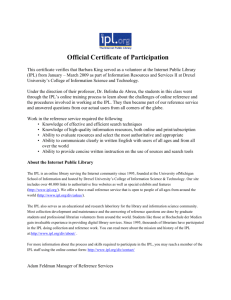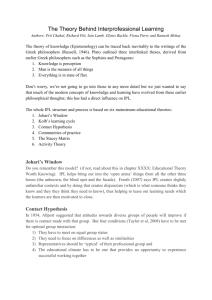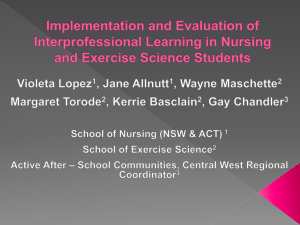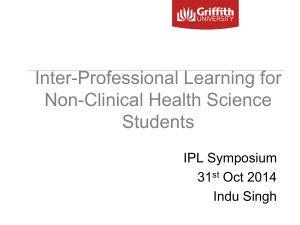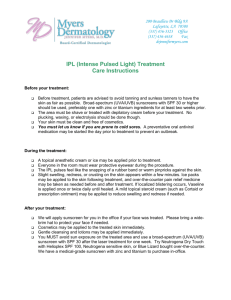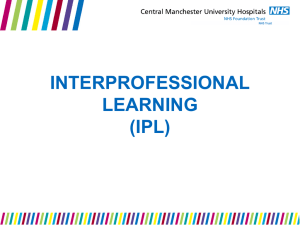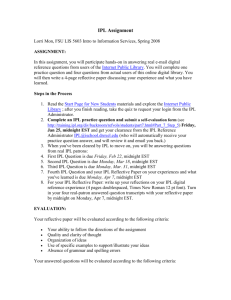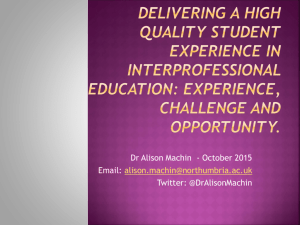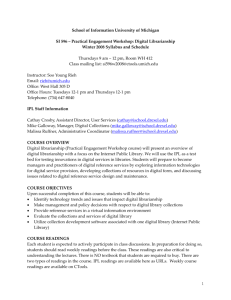Educational strategies for enhancing IPL: Learning together
advertisement
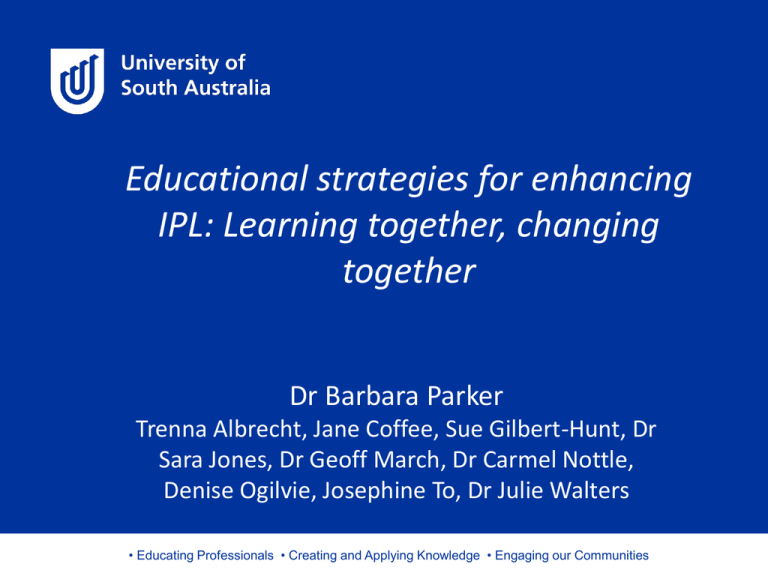
Educational strategies for enhancing IPL: Learning together, changing together Dr Barbara Parker Trenna Albrecht, Jane Coffee, Sue Gilbert-Hunt, Dr Sara Jones, Dr Geoff March, Dr Carmel Nottle, Denise Ogilvie, Josephine To, Dr Julie Walters • Educating Professionals • Creating and Applying Knowledge • Engaging our Communities Teamwork improves patient outcomes & work environments of health care providers (Way et al. 2003, Learning and Teaching for Interprofessional Practice Australia, 2009, Mann et al. 2010, Schroder et al. 2010) Team training 50% in adverse outcomes Mann (2006) IPL communication tool LOS in ICU 50% Pronovost (2003) Teamwork aligned attitudes Post-op sepsis rates Sexton (2006) Teamwork system clinical error rate (30.9% to 4.4%) 27% in nurse turnover Morey (2002), DiMeglio (2005) What does this mean for UG Health students? • Health disciplines: practical experience is critical • Often discipline specific practice • Rethink models of best practice: shortage of clinical training places, complexity of contemporary practice and workforce constraints, accreditation reqs • Simply merging healthcare professions from different backgrounds into a team does not guarantee that they will have the knowledge, skills or attitude necessary to work collaboratively to enhance patient care (Miller et al. 1999) • Given the multifaceted nature of IPL, need to further understand the processes of learning and change which occur (Mann et al. 2010; Schroder et al. 2012) Division of Health Sciences Profile • Over 7,000 students • Occupational therapy, physiotherapy, medical radiation, podiatry, pharmacy, nursing, midwifery, dietetics, exercise physiology, • 3,500 nursing & midwifery students • State of the art on campus facilities PBL simulated environment: • Health service spans 3 levels • Units: ED, critical care/surgical, medical, palliative care, paediatric, antenatal/birthing unit/post natal, home/nurse practice clinic • Briefing/practice rooms, clean and dirty areas • Staffed by senior practicing nurses & midwives • Assistance of key contacts • Approval HOS, Dean:Health & Clinical Ed • Groups of up to 10 • Email to students within one identified course • Detailed information sheet and consent form Criteria • Students from 7 programs, via existing networks (IPL Learning Group) Consent Recruitment Method • Inclusion Criteria: • full-time • internal student • 18 years or older • Exclusion Criteria: • external students • younger than 18 years • unable to attend all workshop sessions Session structure Week 1 Pre session Post session Introduction to study and staff, orientation to PBLs & Debrief mannequin Reflection on IPL and teamwork Discussion re knowledge of IPL & role of other health Reflection on own role in patient professionals care Review of case 2 Review of Week 1 Debrief Review of excerpts of Week 1 video Reflection on IPL and teamwork Reflection on own role in patient Plan for working as a team care Session structure Week Pre session Post session Debrief Review of Week 2 3 Review of excerpts of Week 2 video Plan for working as a team Reflection on IPL and teamwork Reflection on own role in patient care Discussion re knowledge of IPL & role of other health professionals Feedback on pilot study Standardised patient During the data collection sessions, the simulated patient: • acted out the scenario, • simulated attachments (i.e. oxygen mask, IV tubes, and wound moulage) Data Analysis Focus group data: • analysed and then triangulated (combined) • transcribed verbatim and analysed thematically The researcher: • Viewed each session tape to develop a thematic framework • Quotes were lifted from their original context and re-arranged under the newly-developed appropriate thematic content. • The final stage involved determining the relationship between quotes, and links between the data as a whole. Findings Preparation Understanding roles Support • Valuable additional time in clinical practice prior to formal clinical placements in health settings • More information on the scenario before the workshop • 3 weeks provided opportunity to review and improve practice Preparation Preparation Findings Understanding roles •An opportunity to understand the role of other health professionals •An opportunity to practice how to work in a team with other health professionals Understanding roles Understanding roles Understanding roles Findings Support •A lecturer or clinician from their discipline to discuss care and assist in planning and implementation of care to the ‘patient’ •Another student from their own profession to collaborate with and to discuss care and assist in planning and implementation of care to the ‘patient’ •‘Time out’ from the scenario to liaise with a clinician or another student from own discipline to discuss care and assist in planning and implementation of care to the ‘patient’ Support Incidental findings Flow on effect for staff with greater understanding of roles Job satisfaction and camaraderie What happens when I'm not here? Commitment to develop further IPL opportunities Expensive and requires considerable resources: staffing, space and consumables Summary The Division of Health Sciences InterProfessional Learning Group was convened for the purpose of determining practical IPL opportunities within the School of Nursing and Midwifery PBLs for students across the division. Since the group’s inception, active debate has ensued and opportunities identified for continued improvement and integration of IPL within the health science curriculum. This pilot study was one such opportunity. Small study & cannot generalise but students who had not been on placement identified deficits and learnings in understanding of their role and others within the healthcare team and in patient care.


